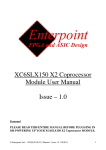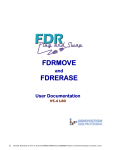Download Merrick6 User Manual Issue – 1.0
Transcript
Merrick6 User Manual Issue – 1.0 © Enterpoint Ltd. – Merrick6 Manual – Issue 1.0 18/03/2012 1 Kit Contents You should receive the following items with your Merrick6 development kit: 1 - Merrick6 Board 2 - Programming Cable 3 - A Programming adapter will be required in order to use the Enterpoint PROG2, PROG3 or standard Xilinx 2x7x2mm programing cables. The JTAG connectors on Merrick6 are 2x6x1.27mm headers. Foreword PLEASE READ THIS ENTIRE MANUAL BEFORE PLUGGING IN OR POWERING UP YOUR MERRICK6 BOARD. PLEASE TAKE SPECIAL NOTE OF THE WARNINGS WITHIN THIS MANUAL. Trademarks Spartan-6, ISE, Webpack, EDK, COREGEN, Xilinx are the registered trademarks of Xilinx Inc, San Jose, California, US. Merrick6 is a trademark of Enterpoint Ltd. © Enterpoint Ltd. – Merrick6 Manual – Issue 1.0 18/03/2012 2 Contents Kit Contents Foreword Trademarks MERRICK6 Introduction MERRICK6 FEATURES FPGAs CONNECTIONS BETWEEN ARRAY FPGAs CONNECTIONS BETWEEN ARRAY AND CONTROL FPGAs CLOCK CONNECTIONS BETWEEN ARRAY AND CONTROL FPGAs SPI FLASH DDR3 MEMORY LEDS ETHERNET CONTROLLER MEMORY CARD HOLDER CLOCK GENERATOR PCIE INTERFACE EXPANSION POWER CONNECTIONS THERMAL MANAGEMENT POWER REGULATORS PROGRAMMING MERRICK6 Programming the Control FPGA © Enterpoint Ltd. – Merrick6 Manual – Issue 1.0 18/03/2012 2 2 2 4 5 6 8 9 10 12 14 15 17 18 20 21 22 23 24 25 26 27 28 3 Programming the Array FPGAs MECHANICAL Medical and Safety Critical Use Warranty Support © Enterpoint Ltd. – Merrick6 Manual – Issue 1.0 18/03/2012 30 33 34 34 34 4 MERRICK6 Merrick6 Merrick 6 in a mini ITX motherboard © Enterpoint Ltd. – Merrick6 Manual – Issue 1.0 18/03/2012 5 Introduction Welcome to your Merrick6 board. Merrick6 is a Spartan-6 based FPGA development board offering a highly powerful approach to prototyping FPGA and System designs . Merrick6 provides high performance computing in a low power package, with a power dissipation of between 15 and 150w. Features include an array containing 6 Xilinx XC6SLX150 FPGAs together with 12 4 Gigabit DDR3 DRAMs. In addition the board features high speed routing across the array and array reload(under 0.25 seconds), a board stacking interface and a PCI-E interface. We are also able to provide a separate algorithm implementation service for customers. The aim of this manual is to assist in using the main features of Merrick6. There are features that are beyond the scope of the manual. Should you need to use these features then please email [email protected] for detailed instructions. Merrick6 is currently fitted with XC6SLX150-2FGG484C Spartan-6 devices. Other variants may be offered at a later date or as an OEM product. Please contact us on [email protected] should you need further information. © Enterpoint Ltd. – Merrick6 Manual – Issue 1.0 18/03/2012 6 Merrick6 Features Expansion/stacking interface Control FPGA XC6SLX150T Clock Generator 1Gbit/s Ethernet PHY PCIE Interface 4 GBit ddr3 serving Control FPGA 2x4 GBit ddr3 per FPGA Array of 6 xc6slx150csg484 FPGAs 2x128Mb SPI Flash User memory Memory Card Holder Rear of Merrick6 board (3d model) © Enterpoint Ltd. – Merrick6 Manual – Issue 1.0 18/03/2012 7 Your Merrick6 will be supplied un-programmed. Unless you have bought an OEM product your board will be supplied with either a Prog2 parallel port programming cable or a Prog3 USB port programming cable. The Spartan-6 FPGAs on the standard Merrick6 board are not supported by the free Webpack version of ISE. You will need version 11.1 SP4, or later, of the ISE tools, which are available from Xilinx to enter and build a design. Using this tool in conjunction with your supplied programming cable you will also be able to program the Spartan-6s, and the supporting SPI Flash, that are on Merrick6. © Enterpoint Ltd. – Merrick6 Manual – Issue 1.0 18/03/2012 8 FPGAs 1 4 2 5 3 6 Merrick6 has a total of 7 FPGAs. There are 6 array FPGAs and one Control FPGA. The standard arrangement is: Control FPGA – XC6SLX150T-FGG900C Array FPGAs - XC6SLX150-FGG484C Merrick6 is normally available with commercial grade -2 speed devices fitted in the XC6SLX150 size. Should you have an application that needs different size FPGAs, industrial parts or faster speed grades please contact sales for a quote at [email protected]. © Enterpoint Ltd. – Merrick6 Manual – Issue 1.0 18/03/2012 9 CONNECTIONS BETWEEN ARRAY FPGAs The Merrick6 Array FPGAs are interconnected as shown in the diagram below. There are 20 connections between each of the FPGAs in a column. These connections are arranged as 10 LVDS pairs. The interconnections are shown in the table below: FPGA BANK 0 PIN FPGA BANK 2 PIN FPGA BANK 0 PIN FPGA BANK 2 PIN B14 W17 B18 T17 A14 V17 A18 T18 C15 Y17 E16 AA21 A15 AB17 D17 AB21 D15 W18 B12 R15 C16 Y18 A12 R16 B16 V18 C13 U16 A16 V19 D14 U17 C17 Y19 C14 T15 A17 AB19 A13 T16 © Enterpoint Ltd. – Merrick6 Manual – Issue 1.0 18/03/2012 10 CONNECTIONS BETWEEN CONTROL FPGA AND ARRAY FPGAs There are 32 connections between the Control FPGA and each of the Array FPGAs: These connections a connect to pairs of IO both at the Array FPGA and at the Controller FPGA. At the array FPGA the IO are on banks 0 and 2 which are fully LVDS capable. At the Controller FPGA the signals are connected to banks 0, 1, 2, 3 or 4. Banks 0 and 2 are fully VVDS capable but banks 1 and 3 have limitations to their LVDS capability which are described in the Xilinx Spartan6 user guide (see ww.xilinx.co.uk). The connections are shown in the table below. The number in parentheses eg (3) shows the IO bank to which the signal connects at the Control FPGA. MASTER FPGA ALL ARRAY FPGAS FPGA1 FPGA2 FPGA3 FPGA4 FPGA5 FPGA6 E5 (4) R21 (1) Y14 (2) G5 (4) T28 (1) AB12 (2) C5 E4 (4) R22 (1) AA14 (2) G4 (4) T30 (1) AC12 (2) A5 H4 (4) R29 (1) AE17 (2) J5 (4) W29 (1) AC11 (2) D6 H3 (4) R30 (1) AF17 (2) J4 (4) W30 (1) AD11 (2) C6 J6 (4) R24 (1) AC19 (2) G3 (4) P26 (1) AB13 (2) B6 H6 (4) R25 (1) AD19 (2) G1 (4) P27 (1) AC13 (2) A6 K2 (4) L21 (0) AD18 (2) H2 (4) P22 (1) AC16 (2) C7 © Enterpoint Ltd. – Merrick6 Manual – Issue 1.0 18/03/2012 11 K1 (4) K21 (0) AE18 (2) H1 (4) P23 (1) AD16 (2) A7 L5 (4) U24 (1) AE21 (2) K4 (4) F23 (0) AG6 (2) B8 L4 (4) U25 (1) AF21 (2) K3 (4) E23 (0) AH6 (2) A8 M4 (4) V23 (1) AF16 (2) J3 (4) W27 (1) AF7 (2) D9 M3 (4) V24 (1) AG16 (2) J1 (4) W28 (1) AG7 (2) C8 M2 (4) P28 (1) AE23 (2) L3 (4) G22 (0) AH7 (2) C9 M1 (4) P30 (1) AF23 (2) L1 (4) F22 (0) AK7 (2) A9 H17 (0) Y24 (1) AC5 (3) C16 (0) AB21 (2) Y2 (3) AA4 G17 (0) Y25 (1) AC4 (3) A16 (0) AC21 (2) Y1 (3) AB4 M13 (0) AA29 (1) Y7 (3) B15 (0) AF25 (2) Y4 (3) Y3 L13 (0) AA30 (1) Y6 (3) A15 (0) AG25 (2) Y3 (3) AB3 L14 (0) AD28 (1) AA10 (3) G20 (0) AD12 (2) AH3 (3) V7 K14 (0) AD30 (1) AA9 (3) F20 (0) AE12 (2) AK3 (3) W8 K10 (0) U27 (1) AB10 (2) P24 (1) AD10 (2) T4 (3) U8 J10 (0) U28 (1) Y12 (2) P25 (1) AE10 (2) T3 (3) T8 J18 (0) AE24 (2) AD4 (3) F17 (0) AD20 (2) W7 (3) AB5 H18 (0) AF24 (2) AD3 (3) E17 (0) AE20 (2) W6 (3) Y5 M15 (0) AC29 (1) Y9 (3) F19 (0) AE19 (2) AJ4 (3) Y6 K15 (0) AC30 (1) Y8 (3) E19 (0) AF19 (2) AK4 (3) W6 H7 (0) T24 (1) W14 (2) J22 (0) V28 (1) V8 (3) R7 G7 (0) T25 (1) Y13 (2) H22 (0) V30 (1) V7 (3) T7 M10 (0) R27 (1) AB14 (2) M23 (1) U29 (1) T2 (3) R8 L10 (0) R28 (1) AC14 (2) M24 (1) U30 (1) T1 (3) R9 F15 (0) AB28 (1) AB10 (2) H16 (0) W21 (1) AG4 (3) V5 E15 (0) AB30 (1) AB9 (2) G16 (0) W22 (1) AH4 (3) U6 © Enterpoint Ltd. – Merrick6 Manual – Issue 1.0 18/03/2012 12 CLOCK CONNECTIONS BETWEEN THE CONTROL FPGA AND ARRAY FPGAS There are 4 connections (2 pairs) between the Control FPGA and each Array FPGA which are primarily intended for the distribution of clock signals, but may be used as General purpose IO if they are not required for this purpose. At the Array FPGA these signals connect to Global Clock pins. The connections are shown in the table below. The number in parentheses eg (3) shows the IO bank to which the signal connects at the Control FPGA. MASTER FPGA ALL ARRAY FPGAS FPGA1 FPGA2 FPGA3 FPGA4 FPGA5 FPGA6 L11 (0) AC27 (1) AE3 (3) F11 (0) AB17 (2) V10 (3) W12 K11 (0) AC28 (1) AE1 (3) E11 (0) AD17 (2) V9 (3) Y12 J12 (0) AD27 (1) AE4 (3) L12 (0) AE9 (2) P7 (3) Y11 H12 (0) AD27 (1) AF4 (3) K12 (0) AF9 (2) P6 (3) AB11 © Enterpoint Ltd. – Merrick6 Manual – Issue 1.0 18/03/2012 13 SPI FLASH MEMORY CONTROL FPGA CONFIGURATION SPI FLASH There are 3 SPI flash memory devices fitted to Merrick6. One is connected to the Control FPGA for configuration code. The second and third devices are connected to the Control FPGA for extra code storage. The details of these devices are shown below. USER STORAGE FLASH 1. The W25Q128BV SPI flash memory U39 device configures the Control FPGA when it is powered providing a suitable bitstream is programmed into the device. The W25Q128BV has a capacity of 128Mbits with a single configuration bitstream for the XC6SLX150T taking 33.9Mbits . Any remaining space can be used for alternative configurations or code and data storage. The W25Q128BV is a quad flash device, and with suitably chosen configuration options will allow the Merrick board to achieve the 100ms minimum PCIE configuration time. After configuration the SPI Flash can be accessed via the following pins of the FPGA: SIGNAL CCLK MISO0/D MISO1/Q MISO2/WP MISO3/HOLD CS FPGA PIN AJ26 AK25 AJ25 AB20 AC20 AK6 W25Q128BV PIN 6 5 2 3 7 1 The flash memory can be programmed using direct SPI programming from the 6x2 programming connector J5. A Programming adapter will be required in order to use the standard Enterpoint or Xilinx 2x7x2mm programming cables. © Enterpoint Ltd. – Merrick6 Manual – Issue 1.0 18/03/2012 14 2 and 3. These W25Q128BV SPI flash memory devices U10 and U11 are available for user code and data storage. They are connected to GPIO on the Control FPGA and can be used in either x1 or x4 mode. The SPI Flash devices can be accessed via the following pins of the FPGA: SIGNAL CCLK MISO0/D MISO1/Q MISO2/WP MISO3/HOLD CS FPGA PIN U10 AD22 AC23 AD24 AC24 AE22 AB23 FPGA PIN U11 AJ17 AA21 AK15 AJ15 AK17 AK16 © Enterpoint Ltd. – Merrick6 Manual – Issue 1.0 18/03/2012 W25Q128BV PIN 6 5 2 3 7 1 15 DDR3 MEMORY CONTROL FPGA DDR3 ARRAY LEFT DDR3 ARRAY RIGHT DDR3 Merrick6 has 13 4GBIT DDR3 Micron MT41J256M16 devices as standard. Each Array FPGA has 2 memory devices connected to it and the Control FPGA has one. Each Array FPGA connects to one DDR3 to its left on Bank 3 and a second to its right on bank 1. These devices are organised as 32 Meg x 16 x 8 banks. They are supported by the hard core memory controller that is in the Spartan-6 FPGAs. To add these cores to your design the COREGEN tool, part of the ISE suite, will generate implementation templates in VHDL or Verilog for the configuration that you want to use. More details on the memory controller can be found in the user guide. http://www.xilinx.com/support/documentation/user_guides/ug388.pdf. The DDR3 devices have 14 address lines and 16 data lines to address all the available memory, which can be accessed at speeds of 1.87ns. More details of the DDR3 can be found in http://download.micron.com/pdf/datasheets/dram/ddr3/1Gb_DDR3_SDRAM.pdf. The DDR3 sites have the following connections to the FPGAs: DDR3 FUNCTION DDR_A0 DDR_A1 DDR_A2 DDR_A3 DDR_A4 DDR_A5 DDR_A6 DDR_A7 DDR_A8 Control FPGA PIN D28 D30 C30 E29 F27 H26 H27 C29 B27 Array FPGA LEFT DDR3 H2 H1 H5 K6 F3 K3 J4 H6 E3 © Enterpoint Ltd. – Merrick6 Manual – Issue 1.0 18/03/2012 RIGHT DDR3 F21 F22 G20 F20 K20 K19 E20 C20 16 DDR_A9 DDR_A10 DDR_A11 DDR_A12 DDR_A13 DDR_A14 DDR_A15 DDR_BA0 DDR_BA1 DDR_BA2 DDR_CS_N DDR_RAS_N DDR_WE_N DDR_DQ0 DDR_DQ1 DDR_DQ2 DDR_DQ3 DDR_DQ4 DDR_DQ5 DDR_DQ6 DDR_DQ7 DDR_DQ8 DDR_DQ9 DDR_DQ10 DDR_DQ11 DDR_DQ12 DDR_DQ13 DDR_DQ14 DDR_DQ15 DDR_LDM DDR_LDQS DDR_LDQS_N DDR_UDM DDR_UDQS DDR_UDQS_N DDR_ODT DDR_CAS_N DDR_RESET_N DDR_CKE DDR_CLK_N DDR_CLK NOCONNECT* TERMINATION* A27 F26 A26 B30 A28 A29 G25 D27 C27 D26 L25 K26 E26 H28 H30 G29 G30 G27 G28 F28 F30 L27 L28 L29 L30 M26 M27 M28 M30 J28 J29 J30 J27 K28 K30 E30 K27 C26 B29 E28 E27 N24 L24 E1 G4 C1 D1 G6 F5 H8 G3 G1 F1 H8 K5 F2 N3 N1 M2 M1 J3 J1 K2 K1 P2 P1 R3 R1 U3 U1 V2 V1 L4 L3 L1 M3 T2 T1 J6 K4 C3 D2 H3 H4 W3,W1,T4,T3,U4,V3,M5 Y2 C22 G19 F19 D22 D19 D20 P20 J17 K17 H18 K18 H21 H19 N20 N22 M21 M22 J20 J22 K21 K22 P21 P22 R20 R22 U20 U22 V21 V22 L19 L20 L22 M20 T21 T22 G22 H22 F18 D21 J19 H20 M19,P19,W20,W22,L17 C19 The signals shown shaded in yellow are terminated using suitable arrangements of resistors. * The Noconnect and Termination pins are required when building some versions of the memory controller core. ISE Version 13 and above permit greater flexibility when assigning these pins than earlier ISE versions. Other unconnected pins may also be available on the Array FPGA Banks. See the schematic diagrams for further information. © Enterpoint Ltd. – Merrick6 Manual – Issue 1.0 18/03/2012 17 LEDS Array FPGA LEDs Control FPGA LED Merrick6 has 25 LEDs. The Control FPGA has a single red LED which is connected to pin AJ1. Each array FPGA has one each of Red, Yellow, Blue and Green LEDs. Blue Green Yellow Red Red Green Yellow Blue The relevant IO pin for an LED needs to be asserted LOW to ensure the specified LED turns on. It may be necessary to assign the pins to 'Z' (High Impedance) in order for the LEDs to be completely 'off'. The table below shows the connections between the Array FPGAs and the LEDs. COLOUR RED YELLOW GREEN BLUE FPGA PIN B1 A2 B2 A4 © Enterpoint Ltd. – Merrick6 Manual – Issue 1.0 18/03/2012 18 ETHERNET CONTROLLER Ethernet controller Merrick6 has a Micrel KSZ9021RL 10/100/1000 Mbps Ethernet PHY fitted, which implements a RGMII version 1.3 transceiver interface. For further information and the component datasheet please refer to www.micrel.com. The connections between the KSZ9021RL device and the Control FPGA are shown in the table below. They are arranged as 4 transmit signals, 4 receive signals, and a 13-bit support bus. RJ45 Magnetically isolated Enternet socket © Enterpoint Ltd. – Merrick6 Manual – Issue 1.0 18/03/2012 19 SIGNAL NAME KSZ9021RL PIN FPGA PIN ETH_TX0 24 C1 ETH_TX1 25 B1 ETH_TX2 26 B2 ETH_TX3 27 A2 ETH_RX0 42 A3 ETH_RX1 41 D4 ETH_RX2 38 C4 ETH_RX3 36 A4 ETH_SUPP1 (ETH_TX_ER) 31 D3 ETH_SUPP2 (ETH_TCK) 32 A5 ETH_SUPP3 (ETH_TXEN_ER) 33 B3 ETH_SUPP4 (ETH_RX_CLK) 46 D2 ETH_SUPP5 (ETH_CLK_MAC_FREQ) 43 D5 ETH_SUPP6 (ETH_MDC) 48 D1 ETH_SUPP7 (ETH_MDIO) 49 E1 ETH_SUPP8 (ETH_INT_N) 51 E3 ETH_SUPP9 (ETH_RESET_N) 56 C5 ETH_SUPP10 (ETH_CLK_TO_MAC) 55 F2 ETH_SUPP11 (ETH_SEL1) 19 F3 ETH_SUPP12 (ETH_SEL0) 21 F4 ETH_SUPP13 (ETH_CLOCK_25MHZ) 60 F1 Signals shown shaded yellow have components between the FPGA pin and the Ethernet controller pin. © Enterpoint Ltd. – Merrick6 Manual – Issue 1.0 18/03/2012 20 MEMORY CARD HOLDER MEMORY CARD HOLDER Further access to data can be achieved using the Memory Card Socket which is connected to the Control FPGA. To use this socket in a design you may need to obtain a license from the SD Association at http://www.sdcard.org/home/. The connections between the Memory Card Socket and the Control FPGA are shown below: MEMORY CARD SOCKET DATA 0 DATA 1 DATA 2 DATA 3 CMD CLK POWER_ON_N CARD PRESENT FPGA PIN D6 A6 C6 B6 A7 B7 C8 D8 The POWER_ON_N pin must be set LOW for power to be supplied to the Memory Card Socket. © Enterpoint Ltd. – Merrick6 Manual – Issue 1.0 18/03/2012 21 CLOCK GENERATOR CLOCK GENERATOR Merrick6 has an IDT5V19EE901NLGI clock generator capable of generating four single ended clocks and one differential clock which are all connected to FPGA. The clock generator is controlled by an SPI interface. More information and a datasheet for this device can be obtained from .www.idt.com The connections between the Clock Generator and the FPGA are shown below: IDT5V19EE901 Function CLKA CLKB CLK C CLK1_P CLK1_N EXP_CLK1_P EXP_CLK1_N CLK2 CLK_X SCLK SDAT IDT5V19EE901 Pin 7 8 24 10 11 14 15 23 30 19 18 FPGA Pin AA1 AA3 V3 W5 W4 AB2 AB1 U1 V4 V1 V2 The Spartan-6 has PLLs and DCMs to produce multiples, divisions and phases of the clock for specific application requirements. Please consult the Spartan-6 datasheet available from the Xilinx website at http://www.xilinx.com if multiple clock signals are required. © Enterpoint Ltd. – Merrick6 Manual – Issue 1.0 18/03/2012 22 PCIE INTERFACE Merrick6 has a x1 PCIE interface which is connected to the control FPGA. The pin out of the SpartanTM-6 FPGA has been chosen such that the PCI interface follows the pinout for the XilinxTM SpartanTM-6 hard core for PCIe which can be generated automatically by the XilinxTM Core Generator. The connections between the PCIe connector and the FPGA are shown below. SIGNAL NAME PCIE CONNECTOR PIN FPGA PIN HS_REFCLK0_P A13 AJ13 HS_REFCLK0_N A14 AK13 HS_TX0_P A16 AJ9 HS_TX0_N A17 AK9 HS_RX0_P B14 AG10 HS_RX0_N B15 AH10 PCIE_PRESENT#1 A1 LINKED TO B17 PCIE_PRESENT#2 B17 LINKED TO A1 PCIE_PWRGD A11 © Enterpoint Ltd. – Merrick6 Manual – Issue 1.0 18/03/2012 AK2 23 EXPANSION CONNECTOR The high speed MGT connections of the Control FPGA that are not used for the PCIE interface are routed to a connector (J6, Samtec type QRF8-026-01-l-RA) at the top of the Merrick6 PCB. This is intended to allow high speed interconnection between the Merrick6 and other circuitry for example stacking of multiple Merrick6 boards. The connections between the Control FPGA and the expansion connector are shown below. SIGNAL NAME EXPANSION FPGA CONNECTOR PIN PIN SIGNAL NAME EXPANSION CONNECTOR PIN FPGA PIN HS_REFCLK1_P 9 B13 HS_TX4_P 2 B9 HS_REFCLK1_N 11 A13 HS_TX4_N 4 A9 HS_TX1_P 14 AJ11 HS_RX4_P 1 D10 HS_TX1_N 16 AK11 HS_RX4_N 3 C10 HS_RX1_P 13 AG12 HS_TX5_P 6 B11 HS_RX1_N 15 AH12 HS_TX5_N 8 A11 HS_TX_CLK_P 10 W19 HS_RX5_P 5 D12 HS_TX_CLK_N 12 Y19 HS_RX5_N 7 C12 HS_TX2_P 18 AJ21 HS_TX6_P 26 B21 HS_TX2_N 20 AK21 HS_TX6_N 28 A21 HS_RX2_P 17 AG20 HS_RX6_P 25 D20 HS_RX2_N 19 AH20 HS_RX6_N 27 C20 HS_TX3_P 22 AJ23 HS_TX7_P 30 B23 HS_TX3_N 24 AK23 HS_TX7_N 32 A23 HS_RX3_P 21 AG22 HS_RX7_P 29 D22 HS_RX3_N 23 AH22 HS_RX7_N 31 C22 Signals shown shaded yellow are connected to J6 via 100nF capacitors. © Enterpoint Ltd. – Merrick6 Manual – Issue 1.0 18/03/2012 24 POWER CONNECTIONS Merrick3 is powered principally from the 12V supply on the disk drive connector. POWER CONNECTOR (DISK DRIVE TYPE) 7A fuse 2.6A fuse A limited 12V supply can be provided using the PCIE connector, but the current available is limited to 2A so this should be avoided unless you know that your design does not consume more current than this. The Merrick6 is protected by 2 fuses, a 2.6A resettable fuse on the PCIE power feed and a 7A fast blow fuse (Littlefuse Series 154) on the supply from the Disk Drive Connector. © Enterpoint Ltd. – Merrick6 Manual – Issue 1.0 18/03/2012 25 THERMAL MANAGEMENT For many applications, particularly where the DDR3 devices are being used at high speed, it will be necessary to implement a system of thermal management to dissipate the heat generated in the FPGAs. 4 holes have been provided for mouning a heatsink or fan over the FPGA array. The design of the thermal management system will depend upon the design implemented in the FPGAs, any enclosure the customer may be using for the Merrick6 board, and the mechanical arrangement of the system into which the Merrick6 board is to integrated. Mounting holes for heatsink or fan The mounting holes are 3.175mm diameter. © Enterpoint Ltd. – Merrick6 Manual – Issue 1.0 18/03/2012 26 POWER REGULATORS 7 6 5 1 2 4 3 Merrick6 has 7 regulators supplying 3.3V, 1.5V, 1.2V and 0.75V power rails. WARNING – REGULATORS CAN BECOME HOT IN NORMAL OPERATION ALONG WITH THE BOARDS THERMAL RELIEF. PLEASE DO NOT TOUCH OR PLACE HIGHLY FLAMABLE MATERIALS NEAR THESE DEVICES WHILST THE MERRICK6 BOARD IS IN OPERATION. Two Micrel MIC26950 regulators (1 and 2 above) supply 1.2V with a maximum total current available of 24A. These provide the core voltage for the FPGAs. A Micrel MIC26950 regulator (3 above) supplies 3.3V with a maximum current available of 12A. This is used for the some of the Array FPGA IOs, most of the Control FPGA IOs, the Ethernet PHY and the Memory card, SPI Flash and Clock Generator . A Micrel MIC26950 regulator (4 above) supplies 1.5V with a maximum current of 12A for the DDR3 and related FPGA I/O. A National Semiconductor LP2996 push-pull regulator (5 above) produces up to 1.5A at 0.75V. This provides the reference and termination voltage for the DDR3 memory and related FPGA I/O. A Diodes Inc. AP7167 linear regulator (6 above) supplies 1.2V at a maximum of 1.2A to the MGT IO on the Control FPGA. An ON Semiconductor NCV1117 regulator (7 above) supplies 5v for the control circuitry of the four MIC26950 devices. © Enterpoint Ltd. – Merrick6 Manual – Issue 1.0 18/03/2012 27 Programming Merrick6 Location of Array JTAG connector J7 Location of Control FPGA JTAG connector J5 The JTAG connectors on Merrick6 are located as shown in the picture above. The connectors are 2x6x1.27mm and an adapter should be used to connect standard Enerpoint programming cables. The adapter is shown below: 1. Programming the Control FPGA The jtag adapter should be fitted to the Merrick6 board as shown below: © Enterpoint Ltd. – Merrick6 Manual – Issue 1.0 18/03/2012 28 The programming of the Control FPGA andits associated configuration SPI Flash device is achieved using the JTAG interface. Principally it is anticipated that a JTAG connection will be used in conjunction with Xilinx ISE software although other alternatives do exist. The Spartan-6 series needs to be programmed using ISE 11 or higher. Versions of ISE prior to 11 do not support Spartan-6. The full version of the Xilinx tools is required to program the XC6SLX150 FPGAs. The JTAG J5 connector has a layout as follows (top view): NC TMS NC TDI NC TDO NC TCK NC GND 3V3 3V3 Using iMPACT Boundary Scan the JTAG chain appears like this: © Enterpoint Ltd. – Merrick6 Manual – Issue 1.0 18/03/2012 29 1. Programming the FPGA directly. Direct JTAG programming of the Spartan-6 FPGA is volatile and the FPGA will lose its configuration every time the board power is cycled. For sustained use of an FPGA design programming the design into the Flash memory is recommended (see 2 below). Direct JTAG programming using .bit files is useful for fast, temporary programming during development of FPGA programs. Right click the icon representing the Spartan-6 FPGA and choose ‘Assign New Configuration File’. Navigate to your .bit file and choose ‘OPEN’. The next dialogue box will offer to add a flash memory and you should decline. Right click the icon representing the Spartan-6 FPGA and choose ‘Program’. On the next dialogue box ensure that the ‘Verify’ box is not checked. (If it is you should uncheck it, failure to do this will result in error messages being displayed). Click OK. The Spartan-6 will program. This process is very quick (typically a few seconds) 2. Programming the SPI flash memory using Boundary Scan. Once the SPI Flash memory has been programmed, the Spartan-6 device will automatically load from the Flash memory at power up. Generation of suitable Flash memory files (.mcs) can be achieved using ISE iMPACT’s Prom File Formatter. The SPI flash memory device is a Winbond W25Q128BV and is arranged as a Quad mode device. X4 mode will need to be selected when the bitfile is generated. Right click on the icon representing the Spartan-6 and choose ‘Add SPI/BPI Flash’ Navigate to your programming file (.mcs) and click OPEN. Use the next dialogue box to select SPI flash and W25Q128BV. Data width should be set to 4. The flash memory should appear as shown below. Right click on the icon representing the flash memory and choose ‘Program’ to load your program into the device. It is recommended that options to ‘Verify’ and ‘Erase before programming’ are chosen. Otherwise all defaults can be accepted. The programming operation will take some time (up to 10 minutes). Depending upon the settings used when generating the bitfile using ISE, it will take up to 20 seconds for the XC6LX150 to configure upon power-up. In order to decrease this time the following process can be followed: 1. In the main ISE menu, right-click ‘Generate Programming file’. Choose Properties. 2. On the left hand side of the Process Properties Dialogue box, choose Configuration Options. 3. The first item on the menu which appears on the right hand side of the dialogue box is ‘Configuration Rate’. The default setting is 2. Increase this number. The maximum value we suggest is 22. Choose ‘Apply’ and ‘OK’. 4. Generate the program file as normal. © Enterpoint Ltd. – Merrick6 Manual – Issue 1.0 18/03/2012 30 2. Programming the Array FPGAs 23 configuration signals have been routed from each array FPGA to the Control FPGA so that fast configuration can take place using the 16 bit master selectmap interface. More information about this configuration scheme can be seen in xilinx user guide UG380 available from www.xilinx.com. The configuration connections between the Array FPGAs and the Control FPGA are shown below: SIGNAL NAME ARRAY FPGAS CONTROL FPGA FPGA1 FPGA2 FPGA3 FPGA4 FPGA5 FPGA6 CONFIG. DATA 0 AA20 H19 AE13 AD7 E7 P3 AB4 CONFIG. DATA 1 U14 F8 AD15 R6 G9 AF11 T8 CONFIG. DATA 2 U13 E8 AE29 R7 E9 Y23 T6 CONFIG. DATA 3 AA6 M19 Y27 AD6 D24 AA15 AD2 CONFIG. DATA 4 AB6 G18 AA27 AE5 C24 AB18 U3 CONFIG. DATA 5 W4 J14 W25 Y11 J20 Y22 W3 CONFIG. DATA 6 Y4 K17 30 W10 H21 AA25 W1 CONFIG. DATA 7 Y7 N27 Y26 AC6 N30 Y15 AH2 CONFIG. DATA 8 AA2 G15 AE28 AA6 K20 AA24 AF1 CONFIG. DATA 9 AB2 H15 AA28 AB6 G21 AC22 AK5 CONFIG. DATA 10 V15 F10 AF15 R5 F9 N3 N5 CONFIG. DATA 11 AA18 L18 AE14 AE7 D7 P2 AH1 CONFIG. DATA 12 AB18 F18 AD14 AB7 J8 R3 AJ2 CONFIG. DATA 13 Y13 F12 AE30 AG1 H11 AA17 T7 CONFIG. DATA 14 AA12 G12 Y28 AG3 G11 AG8 U6 CONFIG. DATA 15 AB12 F14 AB16 AF3 F21 AH8 U7 CCLK Y21 K19 AF13 AF6 F6 P4 AB3 PROGRAM_B AA1 G19 AE27 AA7 D16 Y16 AD1 RDWR_B AB7 N28 AH24 AG5 E21 AC15 AH3 M1 U15 G10 AE15 R4 H8 N4 AK3 M0 A22 J19 AE25 AH5 E6 P1 AA5 DONE Y22 E24 AE26 AE6 N29 N1 AA4 INIT_B T6 L17 W24 AE11 E13 V27 U4 © Enterpoint Ltd. – Merrick6 Manual – Issue 1.0 18/03/2012 31 J7 has been provided in order to simply access the Array using a direct JTAG connection. Fit the JTAg adapter as shown below: The JTAG J7 connector has a layout as follows (top view): NC TDI TMS TCK NC NC GND TDO NC 3V3 NC 3V3 The array FPGA JTAG connections are routed to the Control FPGA as two separate colums of 3 devices. Connections to the Programming connector J7 are also routed to the Control FPGA. Connections need to be made within the Control FPGA to link these together. The following lines of VHDL can be used to achieve this, the result will be that a chain of 6 FPGAs can be accessed on J7. JTAG_T1 <= TMS_ARRAY; --LINKS TMS JTAG_B1 <= TMS_ARRAY; JTAG_T2 <= TCK_ARRAY; --LINKS TCK JTAG_B2 <= TCK_ARRAY; TDI_T <= TDI_ARRAY; -- LINKS TDI - TDO CHAIN TDI_B <= TDO_T; TDO_ARRAY <= TDO_B; The necessary entries in the contraints (.ucf) file are: ################################################### ## CONNECTIONS TO ARRAY JTAG CONNECTOR J7 ## ################################################### NET "TDI_ARRAY" LOC = "AK29" | IOSTANDARD = LVTTL ; NET "TDO_ARRAY" LOC = "AJ28" | IOSTANDARD = LVTTL ; NET "TMS_ARRAY" LOC = "AJ29" | IOSTANDARD = LVTTL ; © Enterpoint Ltd. – Merrick6 Manual – Issue 1.0 18/03/2012 # TDI # TDO # TMS 32 NET "TCK_ARRAY" LOC = "AK28" | IOSTANDARD = LVTTL ; ######################################## ## CONNECTIONS TO LEFT FPGAs JTAG ## ######################################## NET "TDI_T" LOC = "AD9" | IOSTANDARD = LVTTL ; NET "TDO_T" LOC = "F13" | IOSTANDARD = LVTTL ; NET "JTAG_T1" LOC = "AC9" | IOSTANDARD = LVTTL ; NET "JTAG_T2" LOC = "AE8" | IOSTANDARD = LVTTL ; # TCK # TDI # TDO # TMS # TCK ########################################## ## CONNECTIONS TO RIGHT FPGAs JTAG ## ########################################## NET "TDI_B" LOC = "R1" | IOSTANDARD = LVTTL ; # TDI NET "TDO_B" LOC = "B5" | IOSTANDARD = LVTTL ; # TDO NET "JTAG_B1" LOC = "AA11"| IOSTANDARD = LVTTL ; # TCK NET "JTAG_B2" LOC = "AD8" | IOSTANDARD = LVTTL ; # TMS © Enterpoint Ltd. – Merrick6 Manual – Issue 1.0 18/03/2012 33 MECHANICAL ARRANGEMENT The Merrick6 PCB is a standard half-size PCIE PCB. The Dimensions on the drawing below are millimetres (mm). All sizes quoted are subject to manufacturing tolerances and should only be used as a general guide. The height of the Ethernet Connector measured from the lower surface of the board is 13.6mm. The height of the Battery holder measured from the upper surface of the board is 5mm. The PCB is 1.6mm thick © Enterpoint Ltd. – Merrick6 Manual – Issue 1.0 18/03/2012 34 Medical and Safety Critical Use Merrick6 boards are not authorised for the use in, or use in the design of, medical or other safety critical systems without the express written person of the Board of Enterpoint. If such use is allowed the said use will be entirely the responsibility of the user. Enterpoint Ltd will accepts no liability for any failure or defect of the Merrick3 board, or its design, when it is used in any medical or safety critical application. Warranty Merrick6 comes with a 90 day return to base warranty. Do not attempt to solder connections to the Merrick6. Enterpoint reserves the right not honour a warranty if the failure is due to soldering or other maltreatment of the Merrick6 board. Outside warranty Enterpoint offers a fixed price repair or replacement service. We reserve the right not to offer this service where a Merrick6 has been maltreated or otherwise deliberately damaged. Please contact support if you need to use this service. Other specialised warranty programs can be offered to users of multiple Enterpoint products. Please contact sales on [email protected] if you are interested in these types of warranty, Support Please check our FAQ page for this product first before contacting support. FAQ is located at http://www.enterpoint.co.uk/drigmorn/Merrick3_faq.html. Telephone and email support is offered during normal United Kingdom working hours (GMT or GMT + 1) 9.00am to 5.00pm. Telephone - +44 (0) 121 288 3945 Email - [email protected] © Enterpoint Ltd. – Merrick6 Manual – Issue 1.0 18/03/2012 35






















































